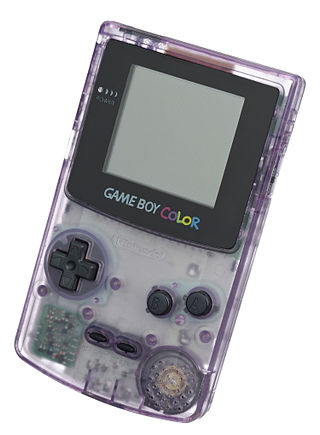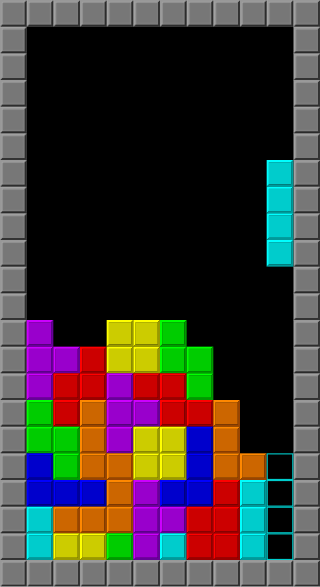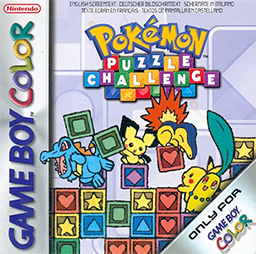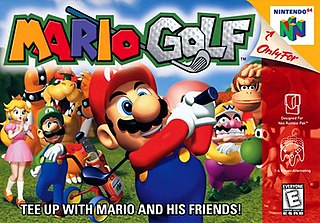
The Game Boy Color is a handheld game console, manufactured by Nintendo, which was released in Japan on October 21, 1998 and to international markets that November. It is the successor to the Game Boy and is part of its product line. Critics like IGN consider it more akin to a hardware revision than a next generation product.

Tetris is a puzzle video game created by the Soviet software engineer Alexey Pajitnov in 1985. It has been published by several companies for multiple platforms, most prominently during a dispute over the appropriation of the rights in the late 1980s. After a significant period of publication by Nintendo, the rights reverted to Pajitnov in 1996, who co-founded the Tetris Company with Henk Rogers to manage licensing.

Dr. Mario is a 1990 puzzle video game developed and published by Nintendo for the Nintendo Entertainment System, Famicom, and Game Boy. It was produced by Gunpei Yokoi and designed by Takahiro Harada. The soundtrack was composed by Hirokazu Tanaka.

Mario Tennis is a 2000 sports video game developed by Camelot Software Planning and published by Nintendo for the Nintendo 64. Following Mario's Tennis, it is the second game in the Mario Tennis series. The game is known for being the introduction of Luigi's arch-rival, Waluigi, and the re-introduction of Princess Daisy and Birdo.

Tetris Attack, also known as Panel de Pon in Japan, is a puzzle video game developed by Intelligent Systems and published by Nintendo for the Super Nintendo Entertainment System. A Game Boy version was released a year later. In the game, the player must arrange matching colored blocks in vertical or horizontal rows to clear them. The blocks steadily rise towards the top of the playfield, with new blocks being added at the bottom. Several gameplay modes are present, including a time attack and multiplayer mode.

Tetris Worlds is a version of the video game Tetris. Originally released in 2001 for Microsoft Windows and Game Boy Advance, it was later released for Xbox, GameCube, and PlayStation 2 in 2002. In 2003, an Xbox Live version and a single-disc compilation version were released for the Xbox. The latter was bundled with Xbox systems.

Pokémon Puzzle League is a puzzle video game in the Puzzle League series developed by Nintendo Software Technology and published by Nintendo for the Nintendo 64. Released in North America on September 25, 2000, and in Europe on March 2, 2001, its Puzzle League-based gameplay has a focus on puzzle-based strategy in the game's grid-based format. To advance to new levels, players are required to combat the game's trainers and gym leaders, similar to the ones featured in Pokémon Red, Blue, and Yellow. One of several games based on the Pokémon anime, it features lead protagonist Ash Ketchum, his Pikachu, his companions Brock and Misty, the Kanto Gym Leaders, and other characters from the series.

Pokémon Puzzle Challenge is a puzzle video game developed by Intelligent Systems and published by Nintendo for the Game Boy Color. Released in Japan on September 21, 2000; in North America on December 4, 2000; and in PAL regions on June 15, 2001, it is the second Pokémon-themed entry in the Puzzle League series. While its Nintendo 64 counterpart Pokémon Puzzle League is visually based on the Pokemon anime, Puzzle Challenge instead draws inspiration from the Pokémon Gold and Silver games. The game features multiple modes of play and support for competitive play between two players. Puzzle Challenge was later digitally re-released via the Nintendo 3DS's Virtual Console line on November 6, 2014.

Wetrix is a 3D puzzle video game developed by Zed Two, the studio of brothers Ste and John Pickford, for the Nintendo 64 and personal computers in 1998, and the Dreamcast and Game Boy Color in 1999. The player's goal is to hold water bubbles falling on a 3D isometric landscape. To do this, enclosures are created with Uppers, which fall in a similar manner to Tetris blocks, that raise the ground. While water can be evaporated with fireballs, hazards such as Mines, Ice Cubes, and earthquakes also fall and ruin the player's construction.

Tetris & Dr. Mario is a 1994 puzzle video game compilation published by Nintendo for the Super Nintendo Entertainment System. It contains enhanced remakes of Tetris (1989) and Dr. Mario (1990), which were originally released for both the Nintendo Entertainment System and Game Boy in North America. Both games include split-screen multiplayer and a "Mixed Match" mode that transitions between the two games.

Tetrisphere is a puzzle video game developed by H2O Entertainment and published by Nintendo for the Nintendo 64. It was released in North America on August 11, 1997, and in PAL regions in February 1998. The game, originally named Phear, was slated for release on the Atari Jaguar in early 1995, but was reworked into a Tetris game for the N64 after Nintendo obtained its publishing rights.

Pac-Attack, also known as Pac-Panic, is a 1993 falling-tile puzzle video game developed and published by Namco for the Super Nintendo Entertainment System and Sega Genesis. Versions for the Game Boy, Game Gear and Philips CD-i were also released. The player is tasked with clearing out blocks and ghosts without them stacking to the top of the playfield — blocks can be cleared by matching them in horizontal rows, while ghosts can be cleared by placing down a Pac-Man piece that can eat them. It is the first game in the Pac-Man series to be released exclusively for home platforms.

Mario Golf is a 1999 sports game developed by Camelot Software Planning and published by Nintendo for the Nintendo 64. Mario, his friends, and his enemies play golf on a variety of Mario-themed courses. Following NES Open Tournament Golf, it is the second game in the Mario Golf series. Camelot also developed a Game Boy Color version, which adds role-playing elements.

Tetris DS is a puzzle video game developed and published by Nintendo. It was released for the Nintendo DS on March 20, 2006, in North America, April 13, 2006, in Australia, April 21, 2006, in Europe, and April 27, 2006, in Japan. An installment of the Tetris franchise, the game supports up to ten players locally, and supported online multiplayer of up to four players using Nintendo Wi-Fi Connection prior to its discontinuation.

Bomberman: Panic Bomber is a 1994 puzzle video game developed and published by Hudson Soft for the PC Engine on December 22, 1994. It was later released for the Neo Geo, Super Famicom, Sharp X68000, FM Towns, NEC PC-9821, Virtual Boy, and PlayStation Portable. It saw a re-release for the Wii and Wii U's Virtual Console services. Panic Bomber is a falling block game with the players' goal being to clear matching blocks using bombs, ensuring that their screen does not fill and that their opponents' screens do. It received mixed to positive reception, identified as a decent game by multiple critics. It has been compared to the falling block puzzle game Tetris. The Virtual Boy version received a mixed reception for its handling of the platform's visual capabilities.

Tetris is a puzzle video game developed and published by Nintendo for the Game Boy in 1989. It is a portable version of Alexey Pajitnov's original Tetris and it was bundled with the North American and European releases of the Game Boy itself. It is the first game to have been compatible with the Game Link Cable, a pack-in accessory that allows two Game Boy consoles to link for multiplayer purposes. A colorized remaster of the game was released on the Game Boy Color titled Tetris DX. A Nintendo 3DS Virtual Console version of Tetris was released in December 2011, lacking multiplayer functionality. The game was released on the Nintendo Switch Online service in February 2023.

Tetris Party is a puzzle video game by Hudson Soft for WiiWare. An installment of the Tetris series, the game supports the use of Miis and the Wii Balance Board, and features both local and online multiplayer in addition to several single-player modes unique to the game.

Tetris: Axis, released as Tetris in some regions, is a puzzle video game developed by Hudson Soft and Bandai for the Nintendo 3DS. The game was released in all regions in October 2011 and was published by Namco Bandai Games in Japan, Nintendo in North America, and Tetris Online in Europe and Australia.

Tetris is a puzzle video game for the Nintendo Entertainment System (NES) released in 1989, based on Tetris (1985) by Alexey Pajitnov. It is the first official console release of Tetris to have been developed and published by Nintendo. It was preceded by an official Tetris for Family Computer in Japan in December 1988, and an unofficial Tetris by Atari in North America in May 1989.

Magical Drop III is a 1997 puzzle video game developed and published by Data East for the Neo Geo arcade and home platforms. It was later ported to Sega Saturn, PlayStation, Neo Geo Pocket Color, Game Boy Color, Windows, and Zeebo. It is the third entry in the Magical Drop series. In the game, the player takes control of one of several characters, battling against computer-controlled opponents. Gameplay is similar to previous entries albeit with further additions; the objective is to clear the screen of constantly advancing colored 'drops' via a character placed at the bottom of the playfield, which can grab drops and make them disappear by putting drops as a column of three or more of the same color. The player can also participate in a board-style adventure mode, while two players can play against each other in a competitive versus mode.




















